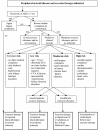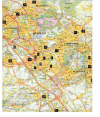The development and implementation of a regional network of physiotherapists for exercise therapy in patients with peripheral arterial disease, a preliminary report
- PMID: 16011806
- PMCID: PMC1185536
- DOI: 10.1186/1472-6963-5-49
The development and implementation of a regional network of physiotherapists for exercise therapy in patients with peripheral arterial disease, a preliminary report
Abstract
Background: Exercise therapy (ET) is the main conservative and proven effective treatment of patients with intermittent claudication. Currently, the most frequent exercise prescription is a single 'go home and walk' advise, without supervision or follow-up. There is no evidence to support the efficacy of this advise and compliance is known to be low. Therefore, a systematic approach was used to guarantee quality and standardisation of treatment, optimal guideline adherence and improved of inter-professional communication between vascular surgeons and physiotherapists. In this preliminary report we would like to outline the steps taken for the development and implementation of the Network Exercise Therapy Parkstad.
Methods: In October 2003 all 59 regional physiotherapy practices were invited to attend a symposium regarding ET in a physiotherapeutic setting. Attending physiotherapists interested in providing ET and willing to follow a certified course on ET, were asked to register. Three tastk groups were formed to accomplish the set targets: Exercise therapy education, Exercise therapy implementation and continuity, and Inter-professional communication in the Parkstad region.
Results: In total 27 physiotherapists, from 22 different practices followed the educational program and are now trained and accredited to provide ET according to the guideline of the Royal Dutch Society for Physiotherapy. A web-based database was designed to contain information on disease specific items provided by the vascular surgery department, and aspects with respect to ET registered by the physiotherapist. The information is regularly updated and available online. Access to the database is restricted to vascular surgeons and physiotherapists in the network. The secondary purpose of the database is to register essential benchmark data for future analysis of ET in a physiotherapeutic setting in the Netherlands and to enable physiotherapists continuous feedback on patient performance. A triage system was developed to detect patients with a compromised cardiac history. This group receives ET at the in-hospital department of revalidation with the possibility of immediate consultation of a cardiologist in case of cardiac complications or even CPR.
Conclusion: The Network Exercise Therapy Parkstad of supervised ET is the first initiative in the Netherlands to provide ET close to the patient's home environment. With the implementation of supervised ET in an outpatient physiotherapeutic setting for all eligible patients with symptomatic PAD, the access to care has been improved. A web-based communication system provides physiotherapists and vascular surgeons with all the necessary and continues updated patient information. Future research, currently in progress, will investigate the therapeutic benefits and cost-effectiveness of exercise therapy in a physiotherapeutic setting.
Figures
References
-
- Leng GC, Fowler B, Ernst E. Exercise for intermittent claudication. Cochrane database Syst Rev. 2000;2:CD000990. - PubMed
-
- Franco A, Legrand E, Guidicelli H, Quesda C, Sarrazin R, Gaultier R. Results of physiotherapy of arterial disease at the stage of intermittent claudication by programed efforts training. J Mal Vasc. 1980;5:185–9. - PubMed
-
- Schoop W. Methods and results of physiotherapy in stage II arteriopathies. J Mal Vasc. 1980;5:181–4. - PubMed
MeSH terms
LinkOut - more resources
Full Text Sources



